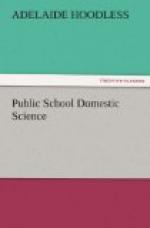FOOTNOTE:
[3] An illustration of vapor rising may be given by breathing upon a mirror.
CHAPTER II.
Food Classification.
The following are familiar examples of compounds of each of the four principal classes of nutrients:
PROTEIN:
Proteids.
Albuminoids, e.g.,
albumen of eggs; myosin,
the basis of muscle (lean meat); the albuminoids
which make up the gluten of wheat, etc.
Gelatinoids, constituents
of connective tissue which
yield gelatin and allied substances, e.g.,
collagen
of tendon; ossein of bone.
“Nitrogenous extractives”
of flesh, i.e., of meats and fish.
These include kreatin and allied compounds,
and are the
chief ingredients of beef tea and most meat
extracts.
Amids: this term is frequently applied
to the nitrogenous
non-albuminoid compounds of vegetable foods
and feeding
stuffs, among which are amido acids, such
as aspartic acid
and asparagin. Some of them are more
or less allied in
chemical constitution to the nitrogenous
extractives of
flesh.
Fats.
Fat of meat: fat of milk; oil of corn, wheat, etc. The ingredients of the “ether extract” of animal and vegetable foods and feeding stuffs, which it is customary to group together roughly as fats, include, with the true fats, various other substances, as lecithians, and chlorophylls.
Carbohydrates, sugars, starches, celluloses, gums, woody fibre, etc.
Mineral matter.
Potassium, sodium,
calcium and magnesium chlorids, sulphates
and phosphates.
(Atwater).
The terms (a) “nitrogenous” and (b) “carbonaceous” are frequently used to designate the two distinct classes of food, viz.: (a) the tissue builders and flesh formers; (b) fuel and force producers.
Each of these classes contains food material derived from both the animal and vegetable kingdom, although the majority of the animal substances belong to the nitrogenous, and the majority of the vegetable substances to the carbonaceous group.
Therefore, for practical purposes, we will confine ourselves to the more general terms used in Atwater’s table.
Uses of Food.
First, food is used to form the materials of the body and repair its waste; second, to yield energy in the form of (1) heat to keep the body warm, (2) to provide muscular and other power for the work it has to do. In forming the tissues and fluids of the body the food serves for building and repair. In yielding energy, it serves as fuel for heat and power. The principal tissue formers are the albuminoids; these form the frame-work of the body. They build and repair the nitrogenous materials, as those of muscle, tendon and bone, and supply the albuminoids of blood, milk and other fluids. The chief fuel ingredients of food are the carbohydrates and fats. These are either consumed in the body or are stored as fat to be used as occasion demands.




